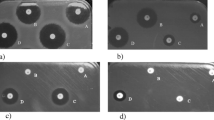Summary
β-Lactamase-producing isolates of Branhamella catarrhalis were first detected in France in 1977. The frequency of β-lactamase producers has increased, especially since 1980.
An agar iodometric test, a fast chromogenic test and an acidimetric test were used to assess the β-lactamase-producing capabilities of 188 isolates of B. catarrhalis obtained mainly from sputum and the pharynx. Data from the first 2 procedures indicated positive β-lactamase activity for all 49 strains of B. catarrhalis identified, but there were some discrepancies in the acidimetric test results. Evidence from a diffusion technique showed significant increases in the inhibition diameters surrounding filter discs impregnated with amoxycillin in the presence of clavulanic acid, or with ampicillin in the presence of sulbactam, compared with discs of the penicillins used alone.
Two types of enzyme activity emerged from examination of isoelectric focusing patterns. Type 1, having pI values of 5.35, 5.55 and 5.85, accounted for 87.2% of the enzyme-producing isolates. Type II, with pIs of 5.5, 5.9 and 6.25, occurred in 12.8% of isolates and appeared to be less widely distributed.
The β-lactamase inhibitors clavulanic acid and sulbactam in combination with benzylpenicillin produced potentiated effects, as demonstrated by significant reductions in MIC (33- and 44-fold decreases, respectively). Higher concentrations of each inhibitor similarly affected the MICs of amoxycillin. A weak synergy occurred with cefoxitin, a β-lactamase-resistant β-lactam antibiotic, and the 2 β-lactamase inhibitors.
Because B. catarrhalis has been shown to be a β-lactamase-producing pathogenic organism, the addition of enzyme inhibitors, such as clavulanic acid and sulbactam, to standard therapy may be beneficial.
Similar content being viewed by others
References
Alvarez S, Jones M, Holtsclaw-Berck S, Guarderas J, Berck SL. In vitro susceptibilities and β-lactamase production of 53 clinical isolates of Branhamella catarrhalis. Antimicrobial Agents and Chemotherapy 27: 646–647, 1985
Barthélémy M, Guionie M, Labia R. Beta-lactamases: determination of their isoelectric points. Antimicrobial Agents and Chemotherapy 13: 695–698, 1978
Buu Hoi-Dang Van A, Brive-Le Bouguenec C, Barthélémy M, Labia R. Novel β-lactamase from Branhamella catarrhalis. Annales de Microbiologie 129B: 397–406, 1978
Courvalin C, Golstein F, Philippon A, Sirot J. Détection de beta-lactamases. In Courvalin et al. (Eds) L’antibiogramme, pp. 225–236, MPC Videom, Brussels, 1985
Doern GV, Sieberg KG, Hallick LM, Morse SA. Antibiotic susceptibility of beta-lactamase-producing strains of Branhamella (Neisseria) catarrhalis. Antimicrobial Agents and Chemotherapy 17: 24–29, 1980
Doern GV, Miller MJ, Winn RE. Branhamella (Neisseria) catarrhalis systemic disease in humans. Case reports and review of the literature. Archives of Internal Medicine 141: 1690–1692, 1981
Eliasson I, Kamme C. Characterization of the plasmid-mediated β-lactamase in Branhamella catarrhalis with special reference to substrate affinity. Journal of Antimicrobial Chemotherapy 15: 139–149, 1985
Farmer T, Reading C. β-Lactamases of Branhamella catarrhalis and their inhibition by clavulanic acid. Antimicrobial Agents and Chemotherapy 21: 506–508, 1982
Hunter PA, Coleman K, Fisher J, Taylor D. In vitro synergistic properties of clavulanic acid, with ampicillin, amoxycillin and ticarcillin. Journal of Antimicrobial Chemotherapy 6: 455–470, 1980
Kamme C, Vang M, Stahl S. Transfer of beta-lactamase production in Branhamella catarrhalis. Scandinavian Journal of Infectious Diseases 15: 225–226, 1983
Labia R, Barthélémy M. L’enzymogramme des bêta-lactamases: adaptation en gel de la méthode iodométrique. Annales de Microbiologie 130B: 295–304, 1979
Labia R, Guionie M, Barthélémy M, Philippon A. Properties of three carbenicillin-hydrolyzing β-lactamases (CARB) from Pseudomonas aeruginosa: identification of a new enzyme. Journal of Antimicrobial Chemotherapy 7: 49–56, 1981
Malmvall BE, Brirsson JE, Johnsson J. In vitro sensitivity to penicillin V and β-lactamase production of Branhamella catarrhalis. Journal of Antimicrobial Chemotherapy 3: 374–375, 1977
Matthew M, Harris AM, Marshall MJ, Ross GW. The use of analytical isoelectric focusing for detection and identification of β-lactamases. Journal of General Microbiology 88: 169–178, 1975
Ninane G, Joly J, Piot P, Kraytman M. Branhamella (Neisseria) catarrhalis as pathogen. Lancet 2: 149, 1977
Ninane G, Joly J, Kraytman M, Piot P. Bronchopulmonary infection due to β-lactamase-producing Branhamella catarrhalis treated with amoxycillin/clavulanic acid. Lancet 2: 257, 1978
Percival A, Corkill JE, Rowlands J, Sykes RB. Pathogenicity of and β-lactamase production by Branhamella (Neisseria) catarrhalis. Lancet 2: 1175, 1977
Riou JY, Guibourdenche M. Diagnostic bactériologique des espèces des genres Neisseria et Branhamella. Annales de Biologie Clinique 35: 73–87, 1977
Riou JY, Guibourdenche M, Courvalin P. Antibiotic susceptibility testing of Neisseria gonorrhoeae by disk-agar diffusion. Annales de Microbiologie 132B: 23–39, 1981
Stobberingh EE, Davies BI, van Boven CPA. Branhamella catarrhalis: antibiotic sensitivities and β-lactamases. Journal of Antimicrobial Chemotherapy 13: 55–64, 1984
Sweeney KG, Verghese A, Needham CA. In vitro susceptibilities of isolates from patients with Branhamella catarrhalis pneumonia compared with those of colonizing strains. Antimicrobial Agents and Chemotherapy 27: 499–502, 1985
Sykes RB, Matthew M. Detection, assay and immunology of beta-lactamases. In Hamilton-Miller & Smith (Eds) Beta-lactamases, pp. 17–49, Academic Press, London, 1979
Vergez P, Riou JY. Etude de la flore bactérienne aérobie isolée des produits de l’expectoration dans les infections chroniques des bronches. Annales de Microbiologie 123: 201–222, 1972
Wise R, Andrews JM, Bedford KA. Clavulanic acid and CP-45,899: a comparison of their in vitro activity in combination with penicillins. Journal of Antimicrobial Chemotherapy 6: 197–206, 1980
Author information
Authors and Affiliations
Rights and permissions
About this article
Cite this article
Philippon, A., Riou, J.Y., Guibourdenche, M. et al. Detection, Distribution and Inhibition of Branhamella catarrhalis β-Lactamases. Drugs 31 (Suppl 3), 64–69 (1986). https://doi.org/10.2165/00003495-198600313-00014
Published:
Issue Date:
DOI: https://doi.org/10.2165/00003495-198600313-00014




